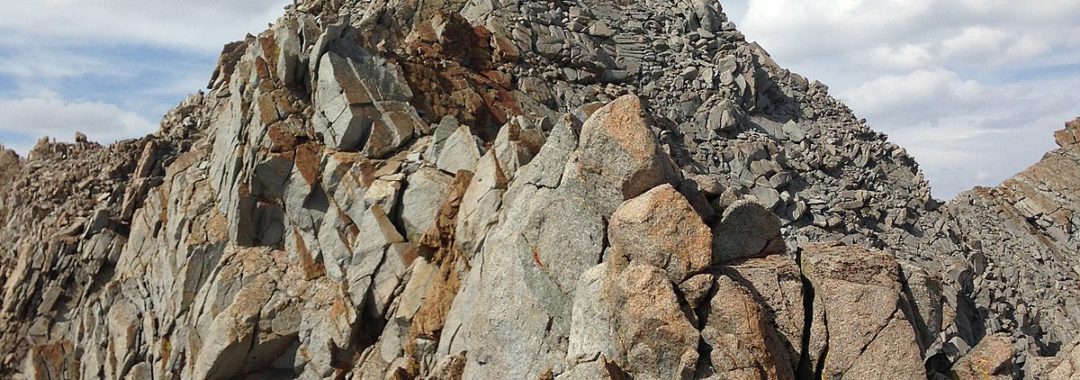In the late afternoon of September 15, 2019, hikers on the Piute Pass Trail outside of Bishop, CA reported to the Inyo County Sheriff’s Office that they heard calls for help and saw people waving their arms on the rugged Southeast Face of Mt. Emerson. The Sheriff’s Office dispatched two Inyo County Search and Rescue (SAR) team members to the scene, where they encountered one member of a three-person climbing party at the base of the Southeast Face of Mt. Emerson. This individual informed the SAR team that he and his two companions were attempting to climb the Southeast Face of Mt. Emerson (III 5.4), but became lost and determined that they could not continue. The reporting party climbed back down to the base of the route to get help, leaving his two companions stranded several hundred feet up the Southeast Face. During the night, the SAR team ascended about 1,000 feet up the route but was unable to locate the two stranded climbers and decided to bivouac for the night at 02:30.
At daylight on the morning of September 16, the two SAR team members continued up the Southeast Face, searching for the stranded climbers, but eventually decided to retreat due to high winds and falling temperatures. During their retreat, at about 09:30, rocks fell from above (likely dislodged by the high winds), striking a SAR team member on his right forearm, breaking his radius and ulna, and on his right hip, causing deep soft-tissue damage. The SAR team apprised the SAR base of their situation, and a team of eight SAR members was dispatched to assist the injured SAR member. Helicopter support was unavailable due to extremely high winds.
While the injured SAR member and his companion waited for the SAR team to climb to their position, they encountered the two purportedly stranded climbers ascending the Southeast Face, having elected to continue up the Southeast Face after bivouacking off-route. The two climbers were advised to wait for rescue with the injured SAR member and his teammate. Once the additional SAR members arrived on scene, they stabilized their injured teammate in a vacuum splint and swath and sling and lowered him approximately 1,000 feet to the bottom of the Southeast Face. The lowering operation used three single-rope, low-angle lowers followed by three double-rope, high-angle lowers to move the injured climber and two assisting rescuers to the base of the route. The stranded climbers were also assisted back to the bottom of the route using a combination of belayed down-climbing, lowering, and tandem rappelling.
An additional four SAR team members, two members of the China Lake Mountain Rescue Group (CLMRG), and a Sheriff’s Deputy brought a litter to the bottom of the Southeast Face, where the injured SAR member was secured in the litter and carried back to the Piute Pass trailhead. At the trailhead, the patient was transferred to an ambulance at about 01:30 on the morning of September 17. Inyo County SAR and the Inyo County Sheriff’s Office thank the CLMRG for their able and expert assistance.
Analysis
The stranded climbers drastically underestimated their undertaking. Although the Southeast Face of Mt. Emerson has a modest rating of 5.4, the route finding is not obvious and the route is fairly long. They left some of their technical gear (a rope and anchoring material) at the base of the route, thinking that they would not need it after they completed the crux first pitch. Had they brought it with them, the abandoned equipment might have given them a means to retreat. They were unprepared for spending an extended period of time on the peak and became extremely cold as a result. The initial call for rescue was due to the climbers’ lack of understanding of the length and complexity of the route, their unpreparedness for the conditions they encountered, and their poor judgment in leaving equipment at the bottom of the route that might have enabled them to self-rescue.
The rockfall that injured the SAR member was a random, spontaneous event. Although the SAR hasty team recognized that conditions were deteriorating and decided to retreat, they fell victim to the objective dangers inherent to the mountain environment.
During the course of the rescue, rockfall remained a threat. Several measures were taken to mitigate this problem, including situating belay and lowering stations in sheltered locations, clearing loose rock from the route when it was safe to do so, moving a single team on rope at a time, and waiting for one team to move away from the base of the cliff before the next team began to descend. These measures were especially important after dark, when it was impossible to see the trajectory of falling rock. Fixed ropes were left over the lower 500 feet of the route to avoid having to retrieve ropes in the dark. This saved time and helped to avoid rockfall after dark. The ropes were retrieved a few days later.
Overall, this incident illustrates the need for parties to maintain the capability for self-rescue, and it serves as a reminder that calls for rescue can expose rescuers to the risk of injury.
